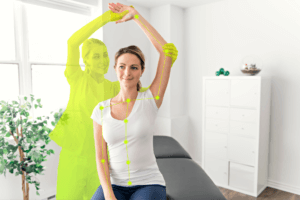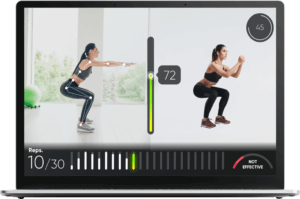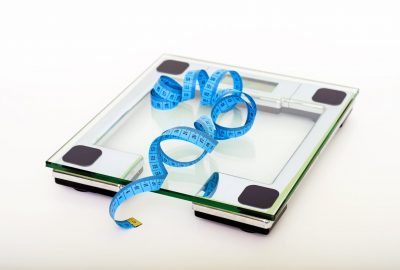For many, the journey to physical well-being is a difficult one. It’s filled with obstacles and distractions that make sticking to any kind of program difficult or impossible. What if there was a technology that could change this? What if the technology automatically adjusted your health and fitness journey based on your evolving physiology, performance, and goals—all in real-time? At a time when the evolution of technology is blamed for our sedentary lifestyle and associated health issues (such as MSK issues or heart disease), creating technology that could activate and inspires people to exercise smarter is highly strategic and favorable.
The ability to track and analyze movement is powerful, but it’s only the first step in creating technology that can help people with physical therapy. The next step is to use Artificial Intelligence to understand the user’s goals (such as increasing range of motion or decreasing pain levels) and provide actionable feedback about how to achieve them. This combination of computer vision and artificial intelligence might to be a game changer for many industries. When it is applied to Physical Therapy, it could become an industry-disrupting innovation. It is time for Physical Therapy to take advantage of this technology and change the way we treat people.
Exercise and AI Fitness Technology: The Perfect Combination
Surprisingly, while the world is continuously disrupted by technology, the Physiotherapy and Fitness industries have not seen any real technological advancements in the last 2 decades. This rings true, especially for the personalization of a user’s health and fitness journey. Covid-19 has proven that personalization based on behavior is not enough; to be truly effective, solutions need to take a user’s actual real-world journey into account. In such a climate, Computer Vision incorporating motion tracking and motion intelligence to understand and track the user’s real-world journey is a critical innovation. Many industry stakeholders are looking at ways to incorporate Computer Vision into their MSK and physiotherapy products and services. Fitness and Wellness, including health insurance providers, have just begun exploring these possibilities.
It is interesting to note that despite the exponential growth of Yoga, Pilates, Reiki, Reflexology, and other techniques in the last decade, the awareness and adoption of physiotherapy as a dedicated service has stayed relatively low. The key deterrent could be the complexity of finding the right therapist coupled with a lack of trust in the process to be relevant and effective. Traditional physiotherapy mostly relies on manual measurements which can be inaccurate, subjective, and in some cases exacerbate the underlying condition. Motion-tracking physiotherapy that employs computer vision technology can help improve the accuracy of exercise feedback in physio by tracking key body metrics such as joint angles, range of motion (ROM), and muscle tone. This could not only aid practitioners with vital corrective feedback during the therapy but also may effectively guide individual patients during their home exercise routine.
Computer Vision Exercises might accelerate an individual’s recovery process through posture and motion analysis during home exercising. Home exercise programs could further evolve to become the go-to for busy professionals since machine learning can provide a detailed analysis of posture and immediate, real time feedback while exercising so that one may easily identify areas of improvement.
Technological innovations for personalized fitness solutions
You don’t have to be a fitness fanatic to enjoy the positive effects of physical activity. Today, technology can inspire you to get moving irrespective of the stage of your fitness journey. The right technology can help you measure, monitor, and improve your fitness levels. From heart rate monitors to step counters, today’s wearables give you access to data that lets you track your progress and stay motivated. The growth of the fitness market has led to an influx of new devices and apps that can help you track your progress. From wrist-worn activity trackers to mobile apps, today’s wearables are designed for a range of purposes from losing weight to ensuring proper water intake. Some devices provide detailed feedback about other critical data like sleep quality and stress levels.
The most accessible technology is probably already in your pocket. Your smartphone can keep track of whether or not you take breaks throughout the day, which will encourage you to move around more often (and burn off some extra calories). There are many intelligent apps available—for example, Google Fit has been designed specifically as a way for people who want to improve their health through increased activity levels but may not have time for traditional forms of exercise such as running or weightlifting at home due to their busy schedules during workdays or weekends.
Exciting changes are unfolding in the area of apparel tech. Smart Fabrics are making their way into commercialized products. As the cost of durability continues to improve, these will be driven into the apparel and accessory markets globally. Over the next decade, smart fabrics will include sensing capabilities that allow users to augment the monitoring and performance of their activity, as well as keep track of critical physiological markers such as blood pressure, glucose levels, and hydration.
Two components seem to be important for the success of any fitness technology: providing users with immediate, relevant feedback and adapting the routines based on their personal goals and real-world performance.
The missing link: Adaptive Feedback and digital physiotherapy
The key issue with current fitness platforms is that they are passive. Technology is only employed to deliver the fitness content, whether it is a ‘personalized’ activity list based on user’s clicks or a gamified set of exercises that are supposed to incentivize the user. They provide users with various information about their workouts, but they do not provide any active corrective feedback on what they’re doing right or wrong. This approach is reactive and does not help users improve over time, which is key for long-term engagement.
When we look at the way people actually exercise, we see that they are constantly seeking feedback on their performance and trying to get better over time. When you run a mile faster than last week, your heart rate drops by 5-10 beats per minute; when you lift more weight on an exercise machine than ever before, your muscles feel more fatigued. If we could harness this data and provide users with the feedback they are looking for, it would make a huge difference to their motivation to continue exercising. Currently, none of the solutions have a link to the real-world journey of the user and are thereby missing this critical need for active feedback.
Only an experienced human therapist who understands the person’s needs, capability, drive, and underlying conditions can currently provide active corrective feedback. This approach too is subjective, since it relies on the individual trainer’s skill and expertise, it is not very scalable either as most people cant afford or don’t have time for too many f2f sessions with a physical therapist Therefore technology that can provide corrective real-time feedback on workouts and physio will be the game changer for retention and user satisfaction. Beyond this, customization of activities using artificial intelligence (AI)-based motion intelligence will change the face of fitness.
This is a huge leap in the right direction. It will allow users to get more out of their workouts, and achieve their fitness goals faster and more effectively. Additionally, AI can also be used for monitoring progress and analyzing data from users across large groups. This will help therapists and trainers create more effective techniques and content by understanding what works best for different populations.
Now you may be wondering how this technology actually works.
Computer vision exercises designed for MSK, Physical Therapy and Fitness
The fascinating technology behind Computer Vision is often used to measure the motion of the body and environment. Computer vision software uses cameras to track movement and analyze the body’s performance during a game or workout program. This type of application coupled with AI provides insights into areas such as posture, speed, acceleration and deceleration times, hand-eye coordination, calorie burn rate, degree of rotation, etc.
A basic real-world application for this technology is analyzing athletes’ performances after injury or surgery. Using infrared cameras mounted near swimming pools to capture footage which can then be analyzed by professional physiotherapists who can assess an athlete’s mobility levels over time post-surgery/injury is an interesting use case. This allows individuals to better understand their progressions towards returning to full strength after surgery/injury so they know when it’s safe enough for them.
Sensorless Computer Vision for Physio or Fitness means that instead of relying on motion sensors or specialized cameras to track workouts and therapy sessions, a real time video feed along with AI motion tracking is used to identify each person’s unique anatomy before beginning any form of exercise. The AI might also consider other data such as gender, age, demography, BMI, and health condition – so that users have access to customized live feedback! It can also allow machines like treadmills or ellipticals to identify who is using them based on their physical characteristics (height/weight etc), which means they could adjust automatically so everyone gets an ideal workout or recovery experience regardless of the stage of their fitness journey.
Computer Vision Exercise enabled by AI could also allow for better data collection and analytics. It can track each user’s progress in real-time, allowing them to see how many calories they’ve burnt, how much time it took to complete certain activities, and provide feedback on their form during workouts. With the help of previous workout data, the AI might also predict how each user will respond to different types of exercise and suggest new ways to get the most out of a session. By analyzing minute changes in muscle tension, body temperature, heart rate, etc., this technology can tell when someone is getting tired and remind them to take a break or adjust their routine accordingly.
Fitness technologies enabled by computer vision and AI can further be used in conjunction with other technologies like virtual reality and augmented reality to provide more immersive experiences. The MSK and physiotherapy industry is a multi-billion-dollar business. With an estimated 1.7 million people suffering from MSK conditions every year, there’s no doubt that the market is growing rapidly.
How is the fitness AI market?
As we move towards a culture where people work primarily in digital spaces, there is an increasing physical health crisis. According to the World Health Organization (WHO), physical inactivity is one of the leading risk factors for disease, disability, and premature death worldwide. In addition, global obesity rates have increased to 30% of the world population in 2021 and Musculoskeletal conditions are the leading contributor to disability worldwide, with low back pain being the single leading cause of disability in 160 countries.
With the holistic well-being of the workforce being one of the critical factors to corporate success, a need for technology-enabled, active, and engaging corporate wellness platforms has increased worldwide. Moreover, companies are increasingly focusing on employee well-being as it helps them retain employees by providing high-quality health care benefits. In the US alone, the corporate wellness industry was worth close to $20 billion in 2019.
The rising prevalence of chronic diseases, increasing awareness about the benefits of a healthy lifestyle, and rising disposable income are the major factors driving the growth of the global wellness market. In addition, technological advancements that enable people to be more active and take control of their health are also expected to drive demand for wellness services. The US MSK market was valued at $309 billion in 2021 and is expected to expand at a 7% CAGR, to reach a whopping $ 93.4 billion by 2028.
Kemtai: The Tech-Revolution for MSK, Digital Physiotherapy and Fitness AI
Kemtai’s Motion Intelligence Platform provides a computer vision platform and APIs to help you quickly and easily add motion tracking and AI-guidance to your own platform. Kemtai leverages proprietary AI and advanced Computer Vision, to analyze human motion and provide real-time training feedback that might create a safer and more effective exercises for physiotherapy and fitness. The technology could adapt the exercise to the user based on what they are doing during the session. The brilliance of Kemtai’s technology is its simplicity. It provides a personalized experience with real time feedback on a browser without requiring any accessories, sensors or expensive devices. Kemtai’s Motion Tracking technology can be coupled with existing physiotherapy and fitness offerings to supercharge the technological value of the offering. Partners can integrate Kemtai’s fitness and therapy exercises and workouts into their application to provide a next-generation experience for their users at home.
From fitness to corporate wellness, through physiotherapy and MSK, Kemtai motion tracking platform could be used across many different industries. We are excited to bring our platform to the market. We believe in its potential to disrupt the industry and look forward to expanding this technology beyond physiotherapy into other fields of medicine as well as fitness programs around the world.



